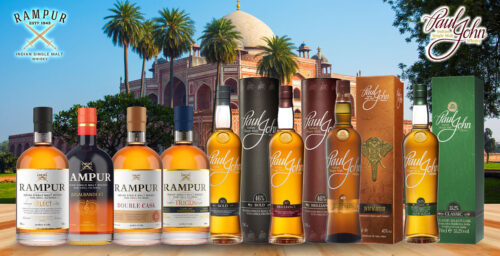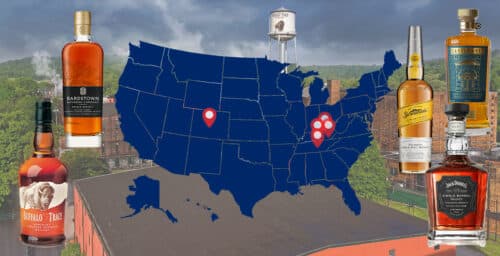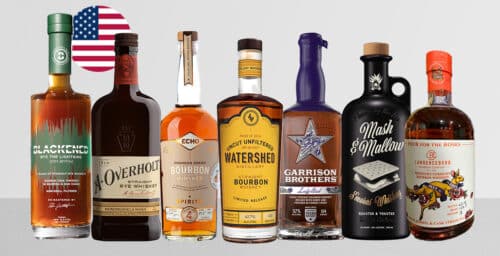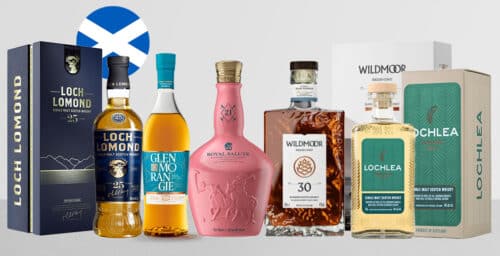Editor’s Note: This is the eighth in a nine part series chronicling the life of James Crow, an extremely important figure in the history of American whiskey. A chemist originally from Scotland, he is credited by some as having invented the sour mash process. Watch this time slot on Thursdays (11am Pacific Time) for the other articles.
Old Oscar Pepper distillery 1865 to 1869
After Oscar Pepper’s death in June 1865, his 35-year-old wife, Nannie took over the farm. Her eldest son, James was 15 years of age, her youngest (Presley) O’Bannon only three. The farm was divided amongst the seven children into varying allotments with O’Bannon awarded an ‘unequal’ 126 acre-block also containing the homestead buildings and distillery complex by the creek, giving Nannie oversight of the distilling business and custodial control of the farm and its assets. In late 1865, Nannie leased the distillery to her neighbour and relative, Thomas Edwards for a single distilling season where he distilled Edward’s whiskey. Edwards had a small distillery on his family farm on Glenn’s Creek, where James Crow worked in 1855 after he left Oscar Pepper’ distillery.
During 1866, she negotiated a three-year lease with John Gilbert Mastin and his brother William. The reputation of Pepper’s distillery for large volumes of high-quality whiskey attracted other distillers in Woodford County to utilize the equipment and expertise of the Pepper staff. John Mastin worked with Thomas Edwards at the distillery during the 1866 season took over Edward’s lease.
He sub-let the distillery to Gaines Berry & Company from January 1st 1867, taking a small share of equity in the Company with his sons John W and Robert Mastin. Edmund Taylor junior had recently joined Gaines, Berry & Company as a partner in 1866. Taylor was also one of Oscar Pepper’s executors and appointed guardian of young James Pepper; he later supported James to take court action over his mother and brother O’Bannon’s share of the farm and distillery, which he won in October 1869.
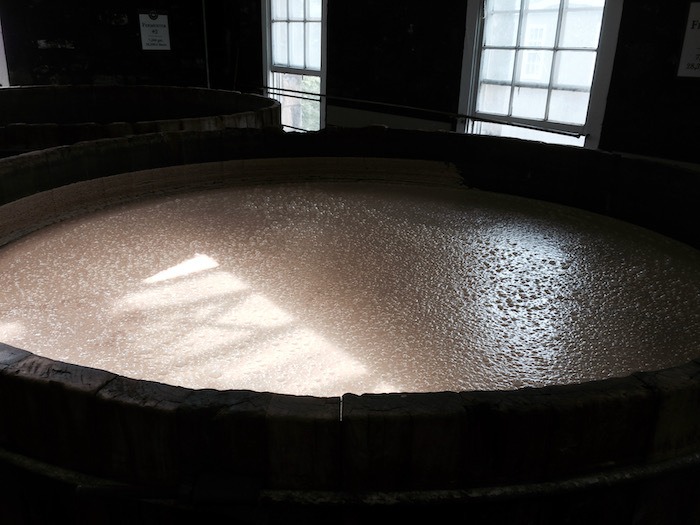
James bought out his other five siblings shares to gain control of the farm and assets. Taylor became a shareholder in the Old Oscar Pepper distillery in 1869, after loaning James Pepper $25,000 to buy-out his siblings and upgrade the plant to 45 bushels a day. However, by May 1877 the distillery was forced into insolvency due to the economic downturn of the Long Depression. The distillery was sold to Taylor’s business partner, George Stagg who also bought Taylor’s two other distilleries, the OFC and Carlisle in Frankfort. In May 1878, George Stagg sold the Old Oscar Pepper distillery to James Graham. In August, Graham partnered with Frankfort spirits dealer Leopold Labrot three months later, renaming the distillery Labrot & Graham to make Old Oscar Pepper whiskey.
James Pepper went on to build the James E Pepper distillery near Lexington in 1881, and Edmund Taylor built the Old Taylor Distillery in Glenn’s Creek in 1887. The saga of distilling in Glenn’s Creek is a complex tangle of families and neighbors, and it should come as no surprise the site of the Old Taylor distillery was the original site of the Anderson Johnson distillery where Crow once worked. It was sold by Anderson’s son James C Johnson in 1879 to Edmund Taylor and his son Jacob Swigert Taylor. In a final twist, James Pepper sold the 126-acre Pepper farm allotment to a member of the Johnson family, Fantley Johnson in 1882.
When Gaines, Berry & Company took over the Pepper lease, they employed William Mitchell to produce sour mash whiskey the Crow way. William Gaines and Hiram Berry developed plans to build a distillery immediately after the War. During the Reconstruction period, few distilleries in central Kentucky had the commercial resources to invest and produce the volumes they believed would meet future market demand. America’s economic growth after the War and the amendment to Revenue Act cutting the excise from $2.00 a proof gallon to 50 cents saw demand quadruple between 1868 and 1870 to 72,560,000 gallons of spirits in America.
Notwithstanding, Kentucky and the country suffered an economic depression in 1869 when whiskey production reached 9.9 million gallons, falling to 4.5 million in 1871. From 1872 until Prohibition, Kentucky experienced a golden period for its whiskey despite some years of overproduction by the northern corn whiskey distilling combines and when the nation faced repeated cycles of economic hardships.
After the War, Gaines, Berry & Company began planning their new venture in nearby Frankfort, the Hermitage distillery. Finance was arranged through ex-banker and their new partner, Edmund Taylor junior. They acquired land in Frankfort beside the Kentucky River in 1868, and construction started that year with distillery production in 1870. The head distiller was Marion Williams, who trained under William Mitchell at the Old Oscar Pepper distillery since February 1867.
While the Hermitage distillery was under development Gaines, Berry & Company leased two distilleries on Glenn’s Creek in Woodford County, the Old Oscar Pepper and the Anderson Johnson distillery, where James Crow was employed when he died in 1856. The combined daily capacity of both distilleries was up to 45 bushels. Assuming they could have purchased either site from the owners, both distilling sites had limitations for expansion due to limited spring water volumes.
Gaines, Berry & Company’s whiskey ambitions did not stop with the construction of the Hermitage distillery and their two leased distilleries.
Old Crow Distillery
In early June 1868, Gaines, Berry & Company purchased 25 acres from Dr James Botts and his wife Judith by Glenn’s Creek, about three miles from the Old Oscar Pepper distillery to build the Old Crow distillery. A new company, W A Gaines and Company, was registered when their New York agents Paris, Allen & Company became investors in the combined assets of Old Crow and the Hermitage distilleries. Paris, Allen & Company were appointed New York agents in 1868 and were keen to invest in whiskey distilling, especially one with the pre-requisite credentials linked to James Crow’s whiskey legacy. The footprint of the distillery’s land increased to over 48 acres in the 1870s.
Construction started in late June, and the distillery completed in 1870. Temporary facilities or a pre-existing stillhouse on the premises allowed production to start mid-August 1869. William Mitchell moved from the Old Oscar Pepper distillery as head distiller, and Van Johnson oversaw the mash room. In 1872, Mitchell left Old Crow to start a distillery at Long Branch near Lexington, after which Van Johnson took over. He remained head distiller until the first years of the new millennial when his son, Lee Johnson became head distiller.
Daily capacity during the first few years increased to 84 bushels a day, or about 1,000 barrels a year. Twice the production of Old Oscar Pepper and Johnson distilleries combined, but less than the Hermitage. By the 1880s, now called the Old Hermitage distillery, it claimed a 1,000 bushels a day, and the Old Crow distillery had also expanded to 850 bushels. The Hermitage and Old Crow were the two largest sour mash distilleries in America.
In November 1870, the Old Crow distillery was selling its first production of Old Crow sour mash whiskey to dealers and their agents. The demand for rye whiskey remained strong in America with Kentucky devoting a third of its output to pure rye whiskey from the late 1860s until Prohibition. Pure rye inferred no corn in the mash bill, usually 80% rye with 20% malted (malted rye or barley malt). W A Gaines & Company were one of the few firms who marketed ‘high-grade pure rye sour mash whiskey’ under their Old Crow and Old Hermitage labels from 1870. For agency sales of their rye whiskeys, they appointed in 1868 H B Kirk & Company of New York to distribute both brands, a contract they held until Prohibition.
In November 1870, Edmund Taylor junior liquidated his one-sixth share in W A Gaines and Company for $33,913.15. The other five shareholders were William Gaines, Hiram Berry, Sherman Paris, Marshall Allen and Frank Stevens. By 1887, W A Gaines was the largest straight whiskey company in America producing sour mash (bourbon) and rye whiskey. The Company established a dealer network of hundreds of agencies across the United States.
In the years before the industry overproduction in the mid-1880s, W A Gaines & Company exported Old Crow whiskey through their New York agent to England, Germany and another two dozen countries. Other dealers and distillers exported millions of gallons of young bourbon and rye whiskey barrels only to import it back into America years later as aged whiskey stock.
The US excise laws taxed whiskey after two years in the barrel (three years after May 1880); however, consumer demand was increasing for older whiskey. Aging it in Bermuda, Germany or another country allowed agents to profitably ship it back paying only $2.00 a gallon in customs duty. Had they aged this whiskey in a domestic warehouse, they were liable for 90 cents per gallon excise after only two years (tax increased from 50 cents in March 1875).
After years of storage overseas, the aged whiskey increased in value, with only the customs tax levied on the remaining whiskey volume in barrel, not incur the extra costs for the lost outages if left in America over years of maturation. Some of Old Crow’s older stock used this boomerang route in the decades before Prohibition to minimize duty and domestic maturation losses.
Old Crow whiskey formula changes 1869 to 1905
The new distillery plant and equipment had advanced considerably since the traditional pot stills Pepper and Crow installed in the late 1830s. This meant some of the Crow principles changed to accommodate the new apparatuses, processes and the larger scales of production. The Old Crow distillery commissioned in August 1870, also saw a series of upgrades in the1880s and early 20th century, as well as incremental improvements over the years. Some of the procedures Crow had achieved by 1855 needed modification to accommodate the new equipment and processes at the Old Crow distillery.
These manufacturing innovations and equipment modifications at the Old Crow distillery changed to improve efficiency, yield, cost and quality. By the late 1880s, these alterations at the distillery doubled production volumes. One of the most noticeable improvements was yield per bushel, climbing to 4.2 gallons in the mid-1880s. Compared with the 1850s production at the Oscar Pepper distillery, Crow methods at the modern Old Crow distillery increased twentyfold, and infrastructure demands required quantum adjustments to replicate Crow’s sour mash system by the 1880s.
Limestone water: W A Gaines & Company selected a location by Glenn’s Creek as the spring stream provided sufficient volumes of water to distil 84 bushels a day distillery. When production increased towards 500 bushels a day (capacity of 850 bushels in the 1890s), the distillery bored a 770-foot well to tap an artesian reservoir.
Grain: Increasing cereal demand by new Kentucky distillers and the distillery consuming tens of thousands of bushels a year, the local farmers were unable to meet the supply, with grain sourced through Chicago brokers. Corn was obtained from the expanding north-western corn belt, the fertile prairies stretching from Illinois to Nebraska. Barley was freighted from Milwaukee and Canada, and rye from the Dakotas.
The grain once grown on the Pepper farm was now shipped across State and National borders by railcar to the nearby towns of Frankfort and Lexington where a rail network operated since 1835. Later the Kentucky Highlands Railway opened a branch line into Glenn’s Creek to the Old Crow distillery in April 1908. Until this spur line opened, grain and fuel, Kentucky coal, was transferred to by riverboat or wagon, hauled the last few miles to the distillery, adding up to 15 cents per gallon in additional cartage fees.
Mashing: Old Crow made ‘hand-made sour mash whiskey’; however, the industrialization of production meant hand mashing became more a gesture to a labelling claim than the genuine product process. The distillery installed large iron tanks each over 1,000 gallons to take dozens of bushels per mash.
Mechanical stirrers worked the mash tubs after which the mash was piped into the small tub mash room where it was deposited in wooden tubs of less than 3 bushels’ capacity. Only then it was briefly hand-stirred and left to stand, continuing the diastatic conversion (saccharify) and to start its secondary lactic fermentation. Hand-made was now a nod to tradition and their labelling claim. After standing for at least 12 hours, the mash was piped back to a large iron tank with controlled temperature to complete saccharification.
Sour mash and yeast: After Crow’s death changes were made continuously to the sour mash backset ratios and volumes by different distillers as they adjusted fermentation methods to new equipment and processes. Edson Bradley, President of W A Gaines and distiller at the Old Hermitage, revealed by the late 1880s a more flexible yeasting program when he remarked, “We bring yeast from other the distillery in operation, if we can get it, in the neighborhood (referring to Old Hermitage). If not we start our ferment with compressed yeast, use Fleischmann’s…”
The distillers were very conscious of the role the local microflora played with introduced yeast strains, as Glenn’s Creek microbes colonized the purified culture where Bradley described the terroir-effect, “a peculiar ferment of the locality where the operation is conducted will ultimately prevail. Nothing can prevent this”. Years later Van Johnson stated on yeast-backing another change in yeast policy by adding what appears to be fresh yeast batch, “Then stock it with jug yeast previously prepared”. This supplementary yeasting may explain the yield raised to 5 gallons per bushel before Prohibition.
Fermentation: After the mash stood in the tanks for three days, it was then transferred to one of eight fermenters; following Crow’s dictum of never less than 96 hours, this four-day minimum ferment continued until Prohibition.
Distillation: Before Prohibition, the distillery used six copper pot stills holding around 1,500 gallons of beer, heated by direct fire. These single pot stills were slightly ‘pinched’ for reflux where the head of the still’s body met the long tapering copper neck carrying the lighter distilled vapors to lyne arm or pipe. The pipes took the distillate vapors to an adjacent room where a flake stand filled with cold running water and the serpentine worm condensed the vapors, emptying the distillate into the low wines receiver.
After collecting the low wines these were distilled a second time in the spirit stills, in one of the two doubler stills situated in an adjoining room. A separate set of flake stands with the worms condensed the finished distillate into the high wines receiver. The distillate was piped to two different cistern rooms, each located about 75 feet away from the still house for dilution with water before barrelling to proof gallon then rolled into the warehouse for maturation.
In 1888, the cement rendered cisterns were converted into copper-lined tanks, operating under the assumption extra copper contact would benefit the distillate. Wooden charge stills, or the new copper column beer stills with fractional sieve plates, started to dominate Kentucky’s bourbon production volumes. Old Crow was one of the few distilleries still making whiskey to the old-fashion plan: pure all-copper double distillation by direct fire.
Barrel: By the mid-1880s peak daily production was 850 bushels or about 75 barrels a day. The standard barrel increased to 47 or 48 gallons to uniformly slot into the new rick houses with a patented rack storage system. To efficiently manage barrel movement and monitor leakage, standardized storage formats in the new rick houses required a common barrel size. Distillers were also conscious that location affected maturation differently subject to cask capacity and where barrels were stored in a warehouse.
Old Crow conducted extensive experiments with different types of casks. Intriguingly, ex-sherry butts were re-coppered in barrels, with the distillery noting ‘no appreciable flavor gained’. Tests were conducted on the differences between loose and fine-grained white oak staves. Charring levels assessed different flavor ameliorations by the thickness the charcoal membrane had on filtering fusel oils, and the caramelized wood sugars had on flavor and color.
Buildings and safety: The large increases in production required distillery infrastructure to produce and store the whiskey. Old Crow built the world’s longest brick-barrel warehouse, 535 feet long and 40,000 square feet. At four storeys high it was one of the first rick houses with patent racks and iron shutters for ventilation to assist maturation. The brick barrel houses were heated by a wood-fired furnace in winter to promote extraction and interaction.
The risk of storing such a large volume of flammable liquid had W A Gaines erect a telephone line from the distillery to the Frankfort fire brigade in August 1884. A fire in the neighborhood beside their Old Hermitage distillery in June 1884, and a lightning strike that burnt down Taylor’s OFC distillery by the Kentucky River Frankfort in June 1882, forewarned them and their insurance brokers of the necessity to have fire prevention and mitigation systems. In 1892, they installed one of the first automatic sprinkler systems at both these distilleries.
Electricity was not introduced to the distillery until the 20th-century, requiring distillery boilers to use coal; a wood furnace to heat the warehouses with piped hot water in winter, and illumination was by kerosene lanterns – all represented varying fire risks. By 1886, the three barrelhouses could hold 26,600 barrels. In the 1890s, four more barrels’ houses were built to accommodate the 10,000 plus barrels a year filled, most whiskey was stored for an average seven years, some up to eleven.
Annual production: In 1870 the distillery filled over 1,200 barrels (50,000 proof gallons), increasing to 3,000 barrels by the late 1870s. New distilling plant in the early 1880s increased production to 10,000 barrels (500,00 proof gallons), and by the end 1890s, pre-Prohibition production reached 13,000 barrels (over 600,000 gallons).
Head distiller since 1872, Van Johnson allegedly left Frankfort attorney Thomas Noble Lindsey, his in-camera version of the Old Crow recipe. Presumably when he gave his deposition on January 1902 for an Old Crow trademark legal case. His brief note reaffirmed the flexibility of Crow’s grain recipe when the wrote, ’12 to 15% of barley malt, 8 to 10% rye, ground, and 75 to 80% corn, ground’. He also provided a clue to the hand-made mashing, where after mechanical stirrers rotating in the tanks, the mash was sent to small tubs for hand stirring the mash at a lower temperature.
He also documented a change to Crow’s sour mash yeasting method, stating, ‘add either fresh yeast or yeast was taken from the previous tubs’ to continue the conversion of sugars into distiller’s beer during the latter ferment.
Prohibition and Crow in the modern whiskey period 1920 to 2020
Before Prohibition shutdown, the distilling industry in Kentucky, the Lever Fuel & Food Control Act of August 1917 suspended grain distilleries’ manufacture of whiskey. The passage of the Volstead Act in January 1919 meant further manufacture and sales of alcohol was banned from January 1920. W A Gaines & Company was unable to secure one of the half a dozen medicinal license to sell spiritus frumenti forcing them to liquidate their stock to Otto and Richard Wathen in Louisville, owners of the American Medicinal Spirits Corporation in 1920.
Prohibited from manufacturing and selling whiskey in the US market, W A Gaines & Company incorporated Old Crow in Montreal, Canada in 1920. They licensed the Corby distillery in Corbyville Ontario, a subsidiary of Canadian Industrial Alcohol Ltd, to indirectly exploit the US Prohibition by serving the US public via bootleggers. It was unlikely the Crow sour mash method was made at the Canadian distillery, probably a blended bourbon-style whiskey, as the distillery installed new analyzing and rectifying columns in late 1920 to take advantage of illicit US demand. There were no laws governing whiskey’s product identity in America during Prohibition, allowing National to label the Canadian product, Old Crow bourbon whiskey.
Paradoxically, the September 1916 Ontario Temperance Act prohibited the sale of alcohol in the Province but did not prevent its manufacture and possession. When Prohibition was repealed December 1933, National Distillers Products Corporation controlled about half of the spirits in the United States holding 45% of bonded whiskey at repeal.
In April 1934, National acquired all the stock in W A Gaines & Company formerly operated by American Medicinal Spirits Corporation, including the trademarks, distillery, warehouses and buildings. The following month the Old Crow distillery on Glenn’s Creek was reconditioned to restart production after 17 years in mothballs. Instead of the slow and costly pot still method of distillation, modern column stills with doublers were installed to produce greater volumes at a lower cost. How much of Crow’s previous methods were replicated at the upgraded distillery under the new owners, National Distillers is debatable.
National Distillers made Old Crow one of its leading brands. In 1955 they again upgraded with new column stills and increased the volume as Old Crow to become the bestselling bourbon whiskey brand in America. Old Crow held the sales crown as the biggest selling bourbon until 1971 when the bourbon industry reached peak production, and consumer sales had started to slid backwards.
Consumer case sales peaked for whiskey in 1969, with straight and bourbon whiskeys reaching 29.77 million cases, almost a third of the 87.22 million total whiskey market. America’s 700-odd domestic whiskey brands were about to be severely diminished as the US bourbon, and whiskey market fell off the whiskey cliff. Over the next 15 years, bourbon and straight whiskey sales declined by 57%.
During bourbon’s escalating growth in the 1960s, Crow’s main rival, Jim Beam, saw its bourbon sales rapidly rise, attracting the attention of the American Tobacco Company looking to diversify into new growth industries. In March 1967, American Tobacco’s holding Company, Fortune Brands acquired the James B Beam Distilling Company’s Clermont and Boston distilleries, and brands.
As bourbon sales plummeted through the 1970s and 1980s, National Distillers & Chemical Corporation was forced to sell their whiskey brands, including Old Crow in March 1987 for $545 million to Fortune Brands. After the purchase Fortune closed the Old Crow distillery by Glenn’s Creek and moved production to Beam’s Clermont distillery. Here the grain bill shifted to Beam’s standard grain formula: 75% corn, 13% rye and 12% malt, char barrel #4 and barrel entry of 125 Proof.
Fortune Brands was renamed American Brands in May 1997, and split-off into Beam Inc. in October 2011. The last corporate takeover saw Japan’s Suntory merge with Beam Brands in January 2013 to form Suntory-Beam, where Old Crow continues to reside as an economy, bottom shelf whiskey in the Suntory-Beam product portfolio. Such is life, the rise and fall of the distilling industry, its businesses, and vagaries to its bourbon brands.
In part 9 next week, we conclude The James Crow Chronicles by looking at the modern Old Crow brand and trademark, products and marketing.


